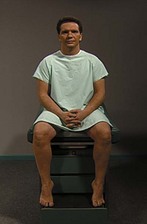Relationship with others in room
Degree of interest in what is happening in room
Alacrity with which you are met
Moistness of palm when you shake hands
Eyes—luster and expression of emotion
Mobility:
Sitting, rising from chair
Speech pattern, disorders, foreign language
Difficulty hearing, assistive devices
Musculoskeletal deformities
Vision problems, assistive devices
Orientation, mental alertness
Significant others accompanying patient
PATIENT INSTRUCTIONS (PLAN EACH STEP SO AS TO MINIMIZE THE PATIENT’S EFFORT AND TO CONSERVE ENERGY)
Remove as much clothing as is necessary (always respecting modesty).
MEASUREMENTS
Measure weight and calculate the body mass index (BMI).
Assess distance vision—Snellen chart.
Document vital signs—temperature, pulse, respiration, blood pressure in both arms.
PATIENT SEATED, WEARING GOWN
Stand in front of patient seated on examining table.
Head and face
Inspect skin characteristics.
Inspect symmetry and external characteristics of eyes and ears.
Inspect configuration of skull.
Inspect and palpate scalp and hair for texture, distribution, quantity of hair.
Palpate temporomandibular joint while patient opens and closes mouth.
Palpate sinus regions; if tender, transilluminate (although often helpful, the sensitivity and specificity of transillumination are uncertain when considered separate from other findings.).
Inspect ability to clench teeth, squeeze eyes tightly shut, wrinkle forehead, smile, stick out tongue, puff out cheeks (CN V, VII).
Test light touch sensation of forehead, cheeks, chin (CN V).
Eyes
External examination:
Inspect eyelids, eyelashes, palpebral folds.
Determine alignment of eyebrows.
Inspect sclerae, conjunctivae, irides.
Palpate lacrimal apparatus.
Near-vision screening—Rosenbaum chart (CN II).
Eye function:
Test pupillary response to light and accommodation.
Perform cover-uncover test and corneal light reflex.
Test extraocular eye movements (CN III, IV, VI).
Assess visual fields (CN II).
Test corneal reflexes (CN V).
Ophthalmoscopic examination:
Inspect disc, cup margins, vessels, retinal surface.
Ears
Inspect alignment and placement.
Inspect surface characteristics.
Assess hearing with whisper test or ticking watch (CN VIII).
Perform otoscopic examination:
Inspect tympanic membranes for landmarks, deformities, inflammation.
Perform Rinne and Weber tests.
Nose
Note structure, position of septum.
Determine patency of each nostril.
Inspect mucosa, septum, turbinates with nasal speculum.
Assess olfactory function when indicated: test sense of smell (CN I).
Mouth and pharynx
Inspect lips, buccal mucosa, gums, hard and soft palates, floor of mouth for color and surface characteristics.
Inspect oropharynx: note anteroposterior pillars, uvula, tonsils, posterior pharynx, mouth odor.
Inspect teeth for color, number, surface characteristics.
Inspect tongue for color, characteristics, symmetry, movement (CN XII).
Test gag reflex and “ah” reflex (CN IX, X).
Perform sense of taste test (CN VII, IX) when indicated.
Neck
Inspect for symmetry and smoothness of neck and thyroid.
Inspect for jugular venous distention (also when patient is supine).
Perform active and passive range of motion; test resistance against examiner’s hand.
Test strength of shoulder shrug (CN IX).
Palpate carotid pulses. Be sure to palpate one side at a time (also when patient is supine).
Palpate tracheal position.
Palpate lymph nodes—preauricular and postauricular, occipital, tonsillar, submental, submandibular, superficial cervical chain, posterior cervical, deep cervical, supraclavicular.
Auscultate carotid arteries and thyroid.




